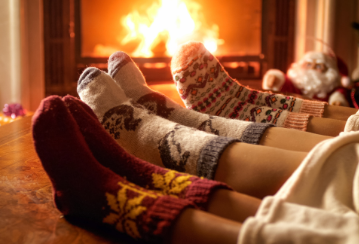News and Updates
Fireplace safety tips for a cozy and safe winter
There’s nothing quite like cozying up by the fireplace on a cold winter’s evening. While many Canadians look forward to the warmth, light and ambiance that comes with a home fireplace, it’s important to practice proper fireplace safety.
Review the following fireplace safety tips to ensure that you, your family and your home stay safe this season.
1. Test smoke alarms and carbon monoxide detectors regularly
You should have at least one smoke detector outside each bedroom and on each level of your home, as well as at least one carbon monoxide detector. These units must be tested regularly, installing new batteries as needed. Older units should typically be replaced every seven to ten years to benefit from the latest technological updates.
2. Have a fire escape plan and practice regularly with all members of your household
Ensure all members of your household are familiar with a fire escape plan, including the location of all fire exits and extinguishers. Your plan should include at least two ways out of every room, especially bedrooms and other sleeping areas. Agree on a meeting place outside your home where all household members can gather and wait for the fire department to arrive. Practice your escape plan at least twice a year, including alternative escape routes.
3. Never leave a fire unattended
Watch your fire closely from start to finish. Ensure the fire is fully extinguished and the fireplace unit and ashes have completely cooled before leaving the room, leaving the house or going to bed. If you have a wood-burning fireplace, use the poker to spread out the remaining embers. This helps them cool faster. You will need to stay by the fireplace until the embers have completely cooled. It is typically safe to remove the ashes by the next day, using a steel shovel and empty metal container.
4. Keep fireplaces free of flammable material
Blankets, pillows, furniture, decorations, trees, wood and other flammable objects must be kept a safe distance away from your fireplace. For wood fireplaces, there should be at least one metre of space between your fireplace and any flammable materials. For gas and electric fireplaces, refer to your manufacturer’s clearance zone indicated in your owner’s manual.
5. Schedule an annual maintenance inspection
 It’s important to know that your fireplace system is functioning properly before turning it on for the season. Have a certified fireplace service technician service your system annually. If you have a wood-burning fireplace, an experienced chimney sweep should be called in once a year to clear the ash and creosote from your chimney and to perform a visual inspection. This is an important step to limit the risk of a chimney fire.
It’s important to know that your fireplace system is functioning properly before turning it on for the season. Have a certified fireplace service technician service your system annually. If you have a wood-burning fireplace, an experienced chimney sweep should be called in once a year to clear the ash and creosote from your chimney and to perform a visual inspection. This is an important step to limit the risk of a chimney fire.
6. Check your local laws
Certain locations have laws regulating the use of home fireplaces. Review the Ontario building code, research your local laws or speak with a member of your local government if you are unsure.
7. Read your owner’s manual carefully
Depending on the type and model of fireplace that you have, there may be additional safety precautions you’ll need to take before turning it on for the season. Read your owner’s manual carefully and follow the manufacturer’s guidelines for best practices.
Enjoy your cozy nights by the fire with the peace of mind that you, your home and your belongings are covered. If you have questions about your home insurance coverage, contact your OTIP broker at 1-800-267-6847. If you would like to get a quote for home insurance, chat with an OTIP broker today at 1-866-561-5559.
If you enjoyed reading this article, subscribe to OTIP’s e-communications and you will get more news like this delivered straight to your inbox. Plus, you will be entered for a chance to win a $500 gift card!







